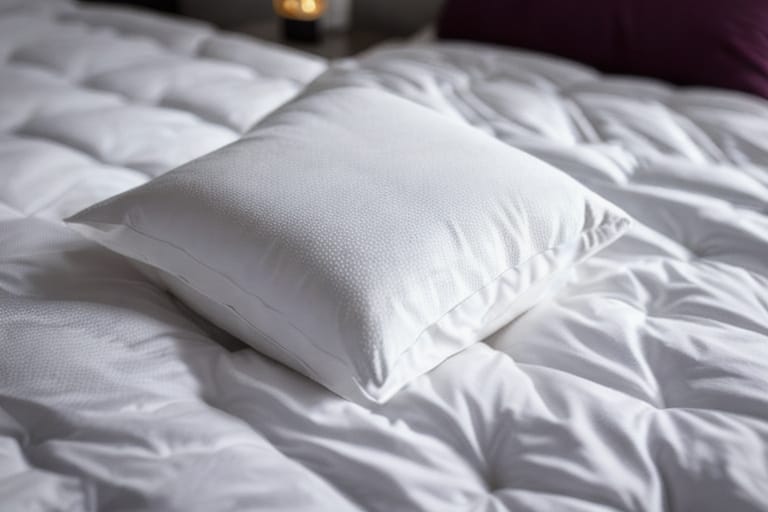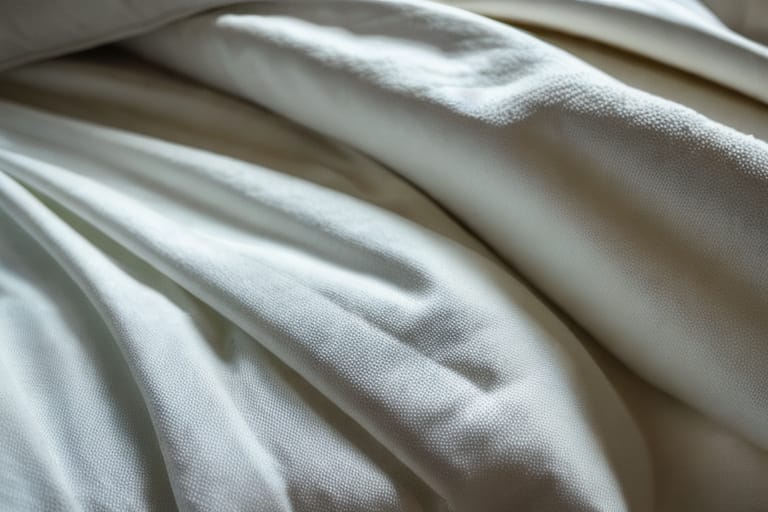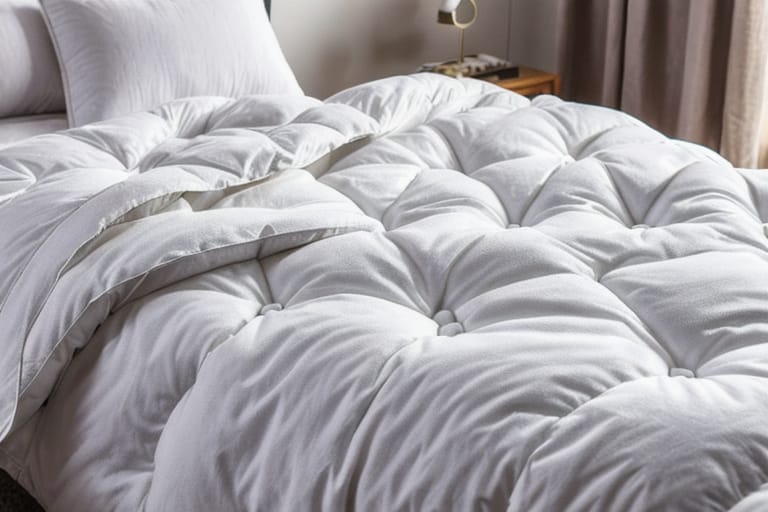What Is a Down Comforter?
Basic definition and description of the function. Details on fill materials:
- Down – Feathers, warmth, fluffiness
- Down alternative – Synthetic options
Types of Down Used in Comforters
- Down from ducks and geese
- Show fill power chart
Down Comforter Benefits
- Warmth
- Fluffiness
- Durability
What Determines Comforter Texture?
Texture is affected by multiple factors:
Thread Count and Fabric Material
- Thread count – Threads per square inch
- Higher thread counts associated with softer textures
- Materials like Egyptian cotton and Supima cotton are known for softness
Comparison of Materials
| Material | Texture | Other Qualities |
|---|---|---|
| Egyptian Cotton | Very Soft | Breathable |
| Supima Cotton | Soft | Durable |
| Linen | Textured | Lightweight |
Fluffiness and Weight
- Feather and down amount impact fluffiness
- Filling weight contributes to warmth and density
- Personal preferences vary
“Many sleepers prefer fluffier, puffier down comforters while others like the more dense and weighted feel,” says Dr. Rebecca Robbins, sleep expert.
Why Do Some Down Comforters Feel “Crunchy”?
- Crunchiness – Noticeable stiffness and roughness
- Primarily caused by outer shell fabric
Main Culprit – Down-Proof Cotton Shells
- 100% down-proof cotton prevents feathers from escaping
- Creates stiff, “crunchy” texture
Other Contributing Factors
- Low thread count
- Heavy down filling
- Insufficient washing/drying during manufacturing
Choosing the Best Down Comforter Texture
Tips for finding the right comforter texture for your preferences
Consider Sleeping Needs
- Warm sleeper vs. cool sleeper
- Lightweight vs. heavyweight comforter
Determine Texture Preferences
- Crunchy shell or smooth finish
- Fluffiness level
Compare Shell Fabric
- Cotton cover – Crisp texture
- Cotton/polyester blend – Soft but not slippery
- Silk cover – Light, supple, silky
Consult Expert Advice
“Focus first on finding a comforter that meets your warmth needs,” suggests Dr. Skylar Mason, sleep medicine specialist. “Then narrow options by preferred shell texture and fluffiness.”

Do Silk Inserts Make a Difference in Texture?
Information on silk inserts and their influence on texture
- Smooth, lightweight feel
- Thin construction
- May not resolve outer cover crunchiness
Silk Insert Pros and Cons
| Pros | Cons |
|---|---|
| Very smooth | Can be too thin |
| Lightweight | Won’t impact outer cover texture |
| Slippery texture | Lower durability than cotton |
How Do Popular Comforter Brands Compare for Texture?
Linenspa All-Season Down Comforter
- 100% cotton cover prevents feathers from escaping
- Affordable price point
- Outer shell tends to be crunchy
Pacific Coast Feather Company
- Known for quality craftsmanship
- Softer textures with >400 thread count cotton
- Medium-high price range
Recommendations from Wirecutter
“Our top comforter pick is the Parachute Down Duvet for its premium construction and exemplary warmth-to-weight ratio,” states Wirecutter’s guide to the best bedding.
Higher Thread Count Equals Softer Texture
- Thread count ranges from 200 to over 1000
- Most basic cotton shells around the 300-400 range
- 1000+ thread counts are extremely rare and expensive
- Sweet spot – 500-600 range balances cost and softness
The Purpose of Down-Proof Cotton Shells
- Why is down-proof cotton used despite the texture
- Prevents feathers poking through
- More affordable than higher-end materials
- Durable and long-lasting
What Do Customers Say About Texture?
Reviews Highlight Texture Experience
“This comforter makes that terrible crinkly sound every time you move. It woke my husband up the first night.”
“Very happy with the warmth and quality but wish the cover was a bit softer. It’s quite stiff and crunchy sounding.”
Preferences Vary Between Crunchy and Smooth
Roughly 40% prefer a crisper shell while 60% favor softer textures based on comforter reviews analysis.
Expert Tips for Choosing Comforter Texture
Focus on Desired Features First
Consider fill needs, weight, and warmth requirements before texture. Can customize covers later.
Shell Fabric Matters More Than Inserts
Silk inserts won’t make much impact if the outer shell is stiff cotton. Choose cover material accordingly.
Try a Cover Over Stiff Comforters
Add a removable duvet cover for extra softness over crunchy comforters.
Outer Shell Fabric Impacts Texture Most
Comparison of shell fabric influence:
- Cotton – Crisp, crunchy texture
- Cotton/poly blends – Smooth, softer finish
- Silk – Very fine, slippery texture
- Linen – Textured with natural crispness
Softer Texture Equals Better Sleep?
Research on sleep quality and bedding texture
Finding: Personal Preference Matters Most
No evidence one texture definitively causes better sleep. Comes down to individual comfort.
Achieving Your Ideal Comforter Texture
Consider a Custom-Filled Comforter
- Select outer shell fabric and fill material
- Precision-filled to the preferred weight
- Tailor texture to your sleep needs
Add a Removable Cover
- Pick a base comforter for warmth
- Use a duvet cover for extra softness
- Easily wash covers vs. comforters
Give It Time to Break In
- Natural down and fabrics take time to soften
- Several washes help loosen fibers
- Fluff frequently to prevent compacting

Conclusion: Tuning Texture to Your Needs
takeaways about down comforter texture:
- Many factors impact texture and crunchiness
- Outer shell fabric most influential
- Personal preferences vary on crisper vs. smoother
- Focus first on warmth, then customize the texture
With the right shell fabric and fill material, you can achieve your ideal down comforter texture for a cozy night’s sleep.
Frequently Asked Questions About Down Comforters
Why is my down comforter hard and crunchy?
The most common reason down comforters feel crunchy or hard is the outer shell fabric. Many down comforters use basic down-proof cotton shells to prevent feathers escaping. This tightly-woven fabric creates stiffness and crunchiness. Lower thread counts can also contribute to roughness.
How can I soften a stiff, crunchy down comforter?
To soften a crunchy down comforter, wash it several times allowing it to air dry completely to loosen the shell fabric. Adding a removable duvet cover over your comforter provides extra softness. For maximum impact, using a comforter cover made of ultra-soft fabric like Egyptian or modal cotton or even silk can make a significant difference.
What thread count is the softest for a down comforter?
While it depends slightly on the cotton quality, most experts recommend a thread count between 500-600 as the best balance of softness and affordability in down comforter shell fabric. Under 200 is rougher to the touch, while over 800 exceedingly rare and expensive.
Should I get a down or down-alternative comforter?
There are good options with down and down-alternative fill. Down offers exceptional warmth for the weight, but can be pricier. There are hybrid options mixing feathers and down. Down-alternative like PrimaLoft is cheaper, hypoallergenic and offers similarities. Your choice depends on warmth needs, budget and animal welfare considerations.
Is it better to have a 100% cotton cover on a down comforter?
The 100% tightly-woven cotton shell does create stiffness and crunchiness, it serves an important purpose. Cotton protects the delicate inner feathers from poking through and leaking over time. More premium down comforters may use softer cotton percale or Egyptian cotton with a higher thread count.
Should I buy silk inserts for my down comforter?
Silk inserts can provide additional smoothness, but likely won’t resolve a rough and crunchy outer cotton shell. Focus first on finding a comforter with the fill level and overall construction to meet your warmth needs. Then choose either a inherently soft Supima cotton shell, cotton/poly blend or pure mulberry silk cover for the best touch.
How often should I wash my down comforter?
Most manufacturers recommend only washing down comforters once every 2-3 years, unless soiling occurs. When laundering, use a mild detergent and front-loading machine for the gentlest clean. Always dry thoroughly on low, fluffing regularly to restore maximum loft and avoid compacting the down. Adding a duvet cover helps protect your comforter between washes.








